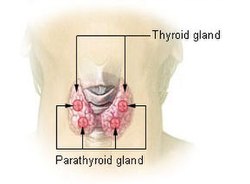Tertiary hyperparathyroidism

Editor-In-Chief: Prab R Tumpati, MD
Obesity, Sleep & Internal medicine
Founder, WikiMD Wellnesspedia &
W8MD medical weight loss NYC and sleep center NYC
| Tertiary hyperparathyroidism | |
|---|---|

| |
| Synonyms | |
| Pronounce | N/A |
| Specialty | N/A |
| Symptoms | Hypercalcemia, bone pain, kidney stones, osteoporosis |
| Complications | Cardiovascular disease, osteitis fibrosa cystica |
| Onset | |
| Duration | |
| Types | |
| Causes | Chronic kidney disease |
| Risks | |
| Diagnosis | Blood test (elevated parathyroid hormone and calcium levels) |
| Differential diagnosis | Primary hyperparathyroidism, secondary hyperparathyroidism |
| Prevention | |
| Treatment | Parathyroidectomy, medication |
| Medication | Calcimimetics, vitamin D analogs |
| Prognosis | |
| Frequency | |
| Deaths | |






Tertiary Hyperparathyroidism is a medical condition characterized by the excessive secretion of parathyroid hormone (PTH) from the parathyroid glands, even after the correction of the long-standing hypercalcemia that is typically associated with secondary hyperparathyroidism. This condition is most commonly seen in patients with chronic kidney disease who have undergone dialysis for a prolonged period.
Etiology[edit]
Tertiary hyperparathyroidism develops as a result of long-standing secondary hyperparathyroidism. The continuous stimulation of the parathyroid glands due to low calcium levels in secondary hyperparathyroidism can lead to nodular hyperplasia, a condition where the parathyroid glands enlarge and produce excessive amounts of PTH, even when the calcium levels return to normal.
Clinical Presentation[edit]
Patients with tertiary hyperparathyroidism may present with symptoms of hypercalcemia, such as polyuria, polydipsia, nephrolithiasis, bone pain, and fractures. Neurological symptoms such as depression, fatigue, and memory loss may also be present.
Diagnosis[edit]
The diagnosis of tertiary hyperparathyroidism is made based on the clinical history, physical examination, and laboratory findings. The hallmark of this condition is the presence of high levels of both PTH and calcium in the blood. Imaging studies such as ultrasound of the neck and scintigraphy can be used to identify the enlarged parathyroid glands.
Treatment[edit]
The primary treatment for tertiary hyperparathyroidism is parathyroidectomy, the surgical removal of the parathyroid glands. This procedure is usually performed when the patient has severe symptoms or when the hypercalcemia is not responsive to medical management. Following surgery, patients may require lifelong supplementation with calcium and vitamin D.
Prognosis[edit]
The prognosis for tertiary hyperparathyroidism is generally good with appropriate treatment. However, if left untreated, the condition can lead to serious complications such as osteoporosis, kidney stones, and cardiovascular disease.
See Also[edit]
Ad. Transform your life with W8MD's Budget GLP-1 injections from $75


W8MD offers a medical weight loss program to lose weight in Philadelphia. Our physician-supervised medical weight loss provides:
- Weight loss injections in NYC (generic and brand names):
- Zepbound / Mounjaro, Wegovy / Ozempic, Saxenda
- Most insurances accepted or discounted self-pay rates. We will obtain insurance prior authorizations if needed.
- Generic GLP1 weight loss injections from $75 for the starting dose.
- Also offer prescription weight loss medications including Phentermine, Qsymia, Diethylpropion, Contrave etc.
NYC weight loss doctor appointmentsNYC weight loss doctor appointments
Start your NYC weight loss journey today at our NYC medical weight loss and Philadelphia medical weight loss clinics.
- Call 718-946-5500 to lose weight in NYC or for medical weight loss in Philadelphia 215-676-2334.
- Tags:NYC medical weight loss, Philadelphia lose weight Zepbound NYC, Budget GLP1 weight loss injections, Wegovy Philadelphia, Wegovy NYC, Philadelphia medical weight loss, Brookly weight loss and Wegovy NYC
|
WikiMD's Wellness Encyclopedia |
| Let Food Be Thy Medicine Medicine Thy Food - Hippocrates |
Medical Disclaimer: WikiMD is not a substitute for professional medical advice. The information on WikiMD is provided as an information resource only, may be incorrect, outdated or misleading, and is not to be used or relied on for any diagnostic or treatment purposes. Please consult your health care provider before making any healthcare decisions or for guidance about a specific medical condition. WikiMD expressly disclaims responsibility, and shall have no liability, for any damages, loss, injury, or liability whatsoever suffered as a result of your reliance on the information contained in this site. By visiting this site you agree to the foregoing terms and conditions, which may from time to time be changed or supplemented by WikiMD. If you do not agree to the foregoing terms and conditions, you should not enter or use this site. See full disclaimer.
Credits:Most images are courtesy of Wikimedia commons, and templates, categories Wikipedia, licensed under CC BY SA or similar.
Translate this page: - East Asian
中文,
日本,
한국어,
South Asian
हिन्दी,
தமிழ்,
తెలుగు,
Urdu,
ಕನ್ನಡ,
Southeast Asian
Indonesian,
Vietnamese,
Thai,
မြန်မာဘာသာ,
বাংলা
European
español,
Deutsch,
français,
Greek,
português do Brasil,
polski,
română,
русский,
Nederlands,
norsk,
svenska,
suomi,
Italian
Middle Eastern & African
عربى,
Turkish,
Persian,
Hebrew,
Afrikaans,
isiZulu,
Kiswahili,
Other
Bulgarian,
Hungarian,
Czech,
Swedish,
മലയാളം,
मराठी,
ਪੰਜਾਬੀ,
ગુજરાતી,
Portuguese,
Ukrainian
